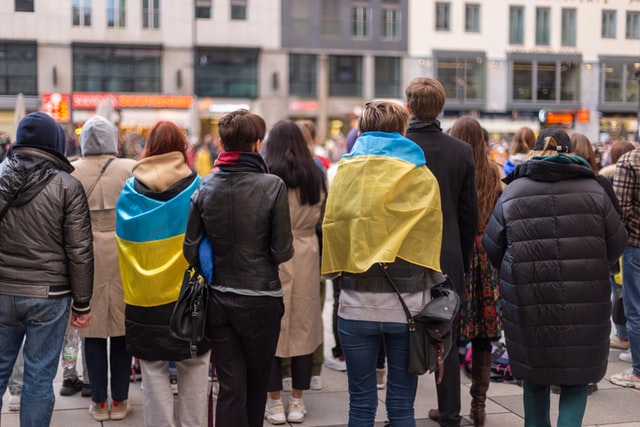
Them vs Us: The Image of Migrants
Article by Elisa Kocadag
Photo by Tetiana SHYSHKINA on Unsplash
“What’s compelling is looking at them, the way they are dressed. These are prosperous middle-class people. These are not obviously refugees trying to get away from the Middle East” describes a reporter regarding Ukrainian migrants for Al-Jazeera[1]. Time and time again the popular rhetoric taken up in society is one in which migrants are categorised as poor, non-white, illegal refugees fleeing their countries. Here there is a clear distinction made between the dominant population of white, middle-class, Christians in the West. This quote reaffirms this. With the recent mass migration of Ukrainians- a largely white, middle-class, Christian population- a group who do not fit this ‘typical’ image of migrants, we see a contrast in the ways in which they are treated and perceived by many similar Middle Eastern migrants whose migration is also a consequence of War.
Here, how states adapt their regulations and attitudes towards migration is very significant. Differing responses can be seen when looking at how Poland treated these different groups of migrants. Syrian migrants attempting to enter Poland, who were similarly victims of Putin’s attacks, were met by the border force by being mercilessly beaten, whereas the recent migrants of Ukraine are met with warm hands and smiles[2]. Not all migrants are treated the same. This aggression towards migrants who do not fit the European, white, category is not a hidden element of Poland’s state’s view. This was seen when Jarosław Kaczyński, the then leader of the Law of Justice Party, and the now current deputy prime minister of Poland, stated, in regard to Muslim refugees, that migrants had brought to Poland “all sorts of parasites and protozoa” [3], due to them being of non-European background. This is a clear attempt to alienate these groups and create a divide between Poland residents and these migrants.
However, further than just through policy, a more direct exemplification of this divide can be seen through media attention, in particular when focusing on the disparities in the wording used to describe both groups of migrants. In an article written by Daniel Hannan, he sympathises with the situation of Ukraine by pointing out that “They seem so like us” and that “War is no longer something visited upon impoverished remote populations”[4]. This wording suggests that rather than the war-torn countries we are used to seeing, such as those in the Middle East, where this is ‘normalised’ because the Ukrainian victims are “like us”, that is the dominant population of the west, that this is a point of concern, of fear and sympathy with these victims. Similarly, Ukraine’s Deputy Chief Prosecutor, David Sakvarelidze, on the BBC, made a direct comment on the appearance of the Ukrainian victims, stating that “It’s really emotional for me because I see European people, with blue eyes and blond hair being killed”[5], implying that their race is a point of tenderness, a reason why they deserve compassion.
From this, we can question the popular argument that suggests that migration is harmful to nations, a narrative which is often pushed forward by politicians, where migration is presented as something that should be feared. This double standard in responses to migrants of Middle Eastern background and those of European backgrounds begs the question, is the problem with migrants or is this proposed issue, in reality, a hidden distaste for those who are perceived as different? Migration has created a new sector of society from which racial injustice can take place[6].
I write this not to suggest that Ukrainians do not deserve this care and security in such a disastrous crisis, but to question why these sympathies and concerns are not similarly extended to those of lower class, non-white, non-European and non-Catholic backgrounds. Why are Ukrainian migrants depicted as those who deserve safety on the basis that they are similar to us, for are we not all human beings? Is there truly any just explanation for this horrid contrast in treatment? I write this not so that Ukrainians become neglected or denied such treatment, but so that we can challenge this clear legitimisation of the position of migrants altogether as harmful and something we should fear. To call out the clear double standards extended towards these two groups.
[1] https://twitter.com/AlanRMacLeod/status/1497976546170216448
[2] https://www.theguardian.com/global-development/commentisfree/2022/mar/04/embraced-or-pushed-back -on-the-polish-border-sadly-not-all-refugees-are-welcome
[3] https://www.politico.eu/article/migrants-asylum-poland-kaczynski-election/
[4] https://www.telegraph.co.uk/news/2022/02/26/vladimir-putins-monstrous-invasion-attack-civilisation/
[5] https://twitter.com/AlanRMacLeod/status/1497974245737050120
[6] Owen, D. (2020). Migration, structural injustice and domination on ‘race’, mobility and transnational positional difference. Journal of Ethnic and Migration Studies, 46(12), 2585-2601.

0 Comments